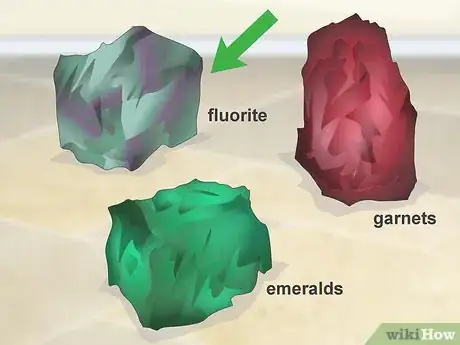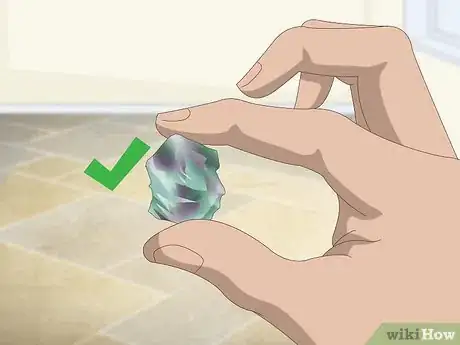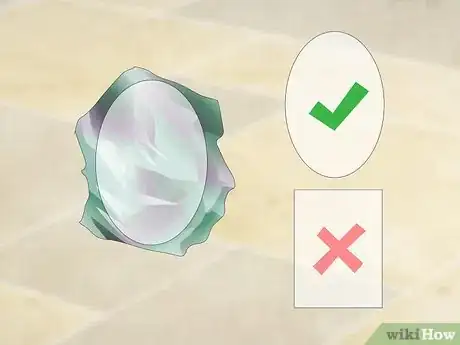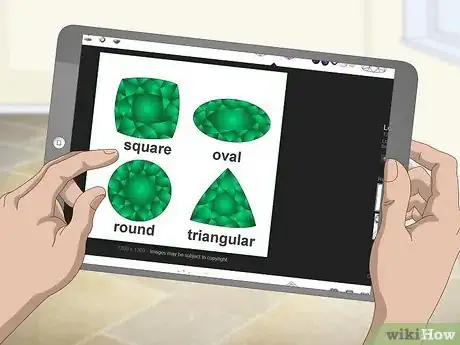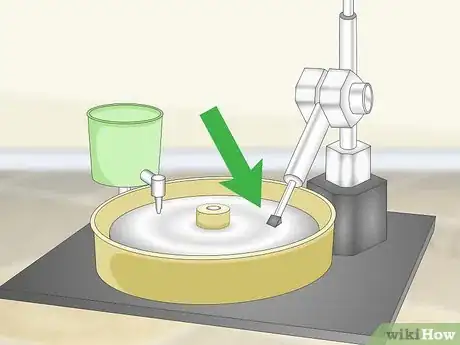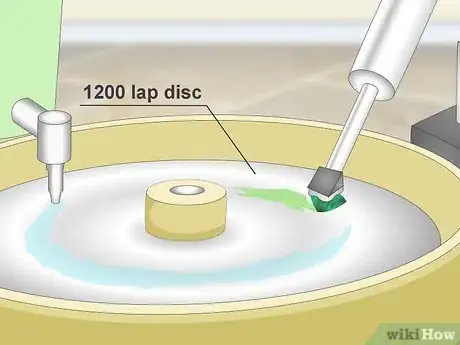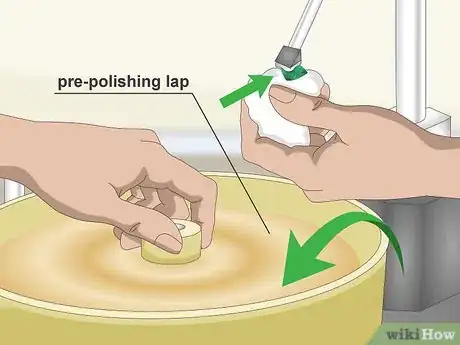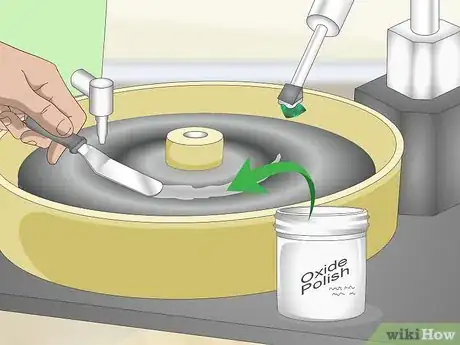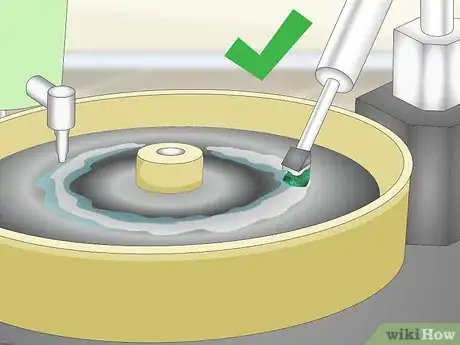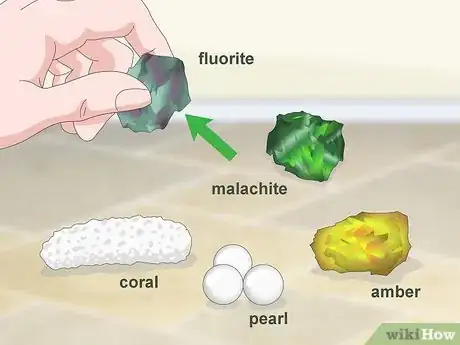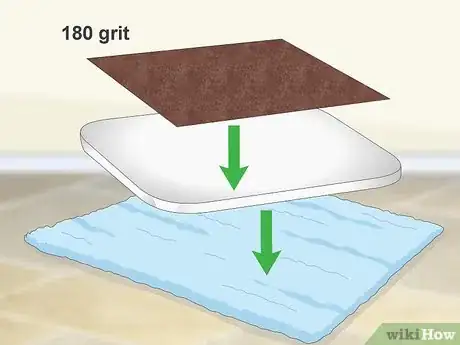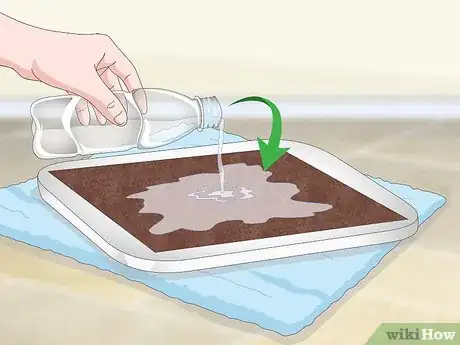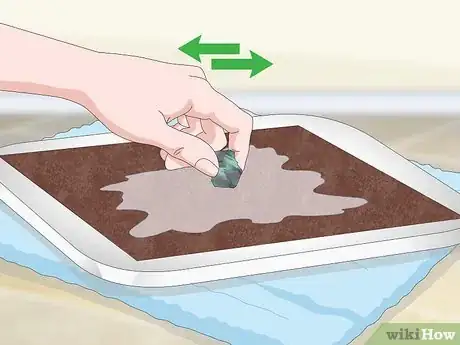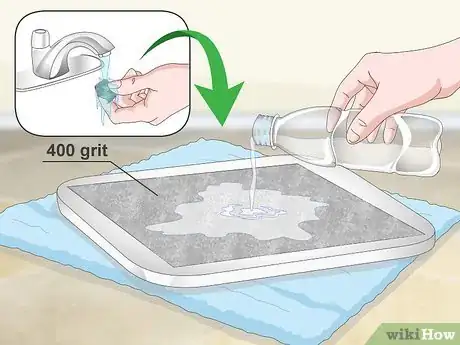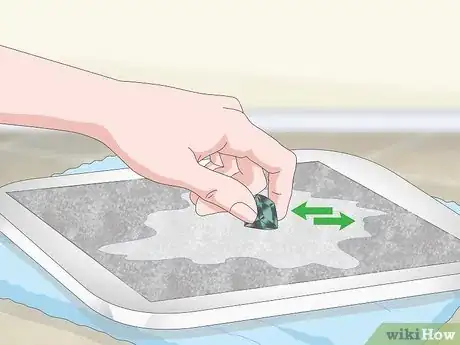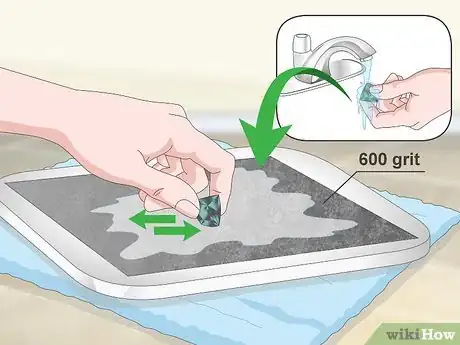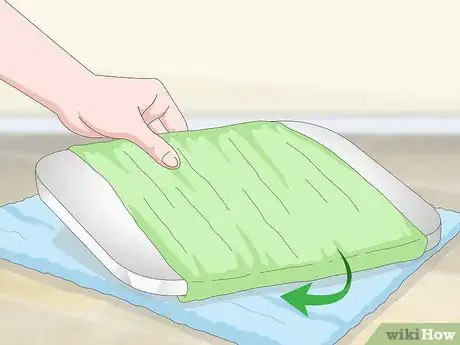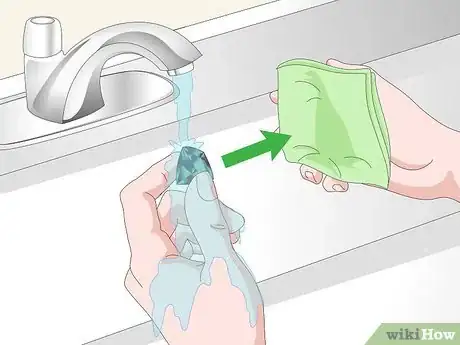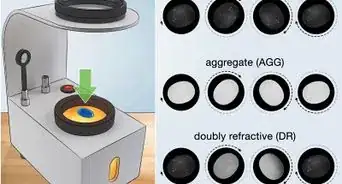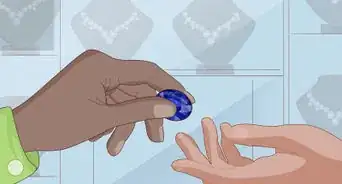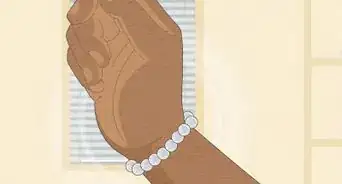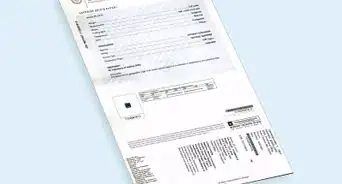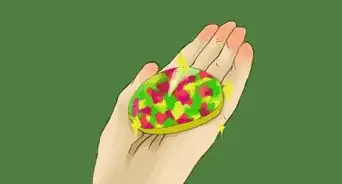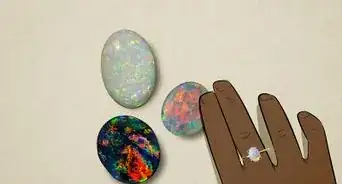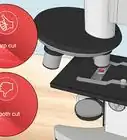This article was co-authored by Kennon Young and by wikiHow staff writer, Jessica Gibson. Kennon Young is a Master Gemologist Appraiser and the Owner of Vermont Gemological Laboratory in Burlington, Vermont. With over 20 years of experience in the industry, Kennon and his team specialize in handmade engagement rings, wedding bands, and custom jewelry. He attended the Revere Academy of Jewelry Arts, the Gemological Institute of America, and the Rhode Island School of Design Extension. He is a Jewelers of America (JA) Certified Bench Jeweler Technician and received the highest credential in the jewelry appraisal industry, the ASA Master Gemologist Appraiser, in 2016.
There are 14 references cited in this article, which can be found at the bottom of the page.
wikiHow marks an article as reader-approved once it receives enough positive feedback. In this case, 87% of readers who voted found the article helpful, earning it our reader-approved status.
This article has been viewed 175,848 times.
Try your hand at cutting and polishing rough or uncut gems. You can decide what shape to make the gem and how many facets it should have. To make a detailed, sparkling gem, use a faceting machine with laps for grinding and polishing. If you don't have access to a machine or don't need as many facets, cut and polish the gem using sandpaper.
Steps
Choosing a Cut
-
1Decide what type of gemstone to cut. Because gemstones can vary in cost, learn to cut and facet less expensive gems. For example, work with fluorite before moving on to more expensive gems such as emeralds or garnets.[1]
- For less expensive gems, start with quartz, fluorite, crystal, beryl, and tourmaline.
- If you're ready to work with semi-precious and precious gems, try sapphires, zircon, garnets, amethysts, and opals.
-
2Buy a rough or uncut gemstone. Decide what type of gem you'd like to cut and look for them at local gem and mineral fairs. You can buy rough or uncut stones directly from dealers which will give you the opportunity to handle the stones in person. You can also buy from dealers online, but you'll need to find a reputable dealer to be sure of what you're getting.[2]
- A reputable online dealer should offer a 30-day return policy, offer a variety of payment options, and offer gem certification from an independent lab.
Advertisement -
3Choose a basic shape for the gemstone. Look at the shape that the rough or uncut gemstone is already in. You might see that the gem already has a slight oval shape, so cutting it to an oval shape would be easier than making it into a square or rectangle cut.[3]
- Remember that the cut gem will be smaller than the rough gem, so choose a shape that won't waste too much of the gem.
- Other basic cuts include round, square, oval, and triangle.
-
4Research cuts for your gem. Once you have an idea of the shape you want for your gem, read books about various cuts. You can also take online tutorials from gem cutters or take classes at local community centers about choosing cuts. Common cuts include:[4]
- Square shapes such as asscher, antique (cushion), princess, emerald, octagon, or baguette.
- Round shapes such as briolette, cabochon, or radiant.
- Oval or triangular shapes such as marquise, trillion (trilliant), or heart.
EXPERT TIPKennon Young is a Master Gemologist Appraiser and the Owner of Vermont Gemological Laboratory in Burlington, Vermont. With over 20 years of experience in the industry, Kennon and his team specialize in handmade engagement rings, wedding bands, and custom jewelry. He attended the Revere Academy of Jewelry Arts, the Gemological Institute of America, and the Rhode Island School of Design Extension. He is a Jewelers of America (JA) Certified Bench Jeweler Technician and received the highest credential in the jewelry appraisal industry, the ASA Master Gemologist Appraiser, in 2016.Master Gemologist Appraiser
 Kennon Young
Kennon Young
Master Gemologist AppraiserThe shape of the gem might be based on the shape of the crystal before it is cut, any inclusions you might want to add, and your price range.
Cutting Hard Gems with a Faceting Machine
-
1Use a faceting machine to preform the gem. Most uncut gems are oddly shaped so you may need to grind it down. Roughly grinding the outsides of the gem will make it closer to the size and shape you want. Hold the gem between your fingertips and carefully polish it on a 1200 grit lap.[5]
- If you have a lot of rough to remove, use a 260 grit lap.
- Since faceting machines are expensive and not usually available for rent, see if you can take a few faceting classes to become familiar with using them. If you want to buy one, find one directly from a manufacturer or look online.
-
2Secure the rough gem to a dop stick using warm wax. Heat a dime-sized amount of dop wax on the end of your dop stick. Hold it near a flame so the wax softens and becomes pliable. Stick the base of the gem that will be mounted into the wax. The faced surface of the gem should be exposed.[6]
- Let the wax cool before you grind it so the gem stays on the dop stick.
- Once you've gained experience, consider using superglue or cyanoacrylate adhesives instead of wax. These are less likely to break off or damage heat-sensitive gems such as opals.
-
3Grind the outlines of the stone to shape the girdle. Use a 1200 lap disc on your faceting machine to cut the circumference (girdle) of the gem. Set the angle to 90 degrees so you can make symmetrical cuts. Don't lock the index wheel on the machine so you can move it freely and have more control over cutting.[7]
- The outline you cut will depend on which shape you've chosen. For example, you'll make a rectangular girdle for an emerald cut.
- Consult the machine's instruction manual for specific instructions about each style of cut.
-
4Wipe grit from the gem and put a pre-polishing lap on the machine. Wipe the gem clean with a microfiber cloth. This will remove the coarser grit that's transferred to the gem. Take the coarser lap disc off of the machine and put a pre-polishing lap on the machine.[8]
-
5Cut the facets according to the shape you want. Find faceting diagrams for the shape you're cutting the gem. A diagram will tell you how many facets to make and at what angles to make them. Polish the facets against the lap until the surfaces of the gem are smooth.
- To get the cut you want, you may have to reheat the dop wax, remove the rough, and reposition it in the hot wax. Heating the stone along with the wax will not harm it.
EXPERT TIPKennon Young is a Master Gemologist Appraiser and the Owner of Vermont Gemological Laboratory in Burlington, Vermont. With over 20 years of experience in the industry, Kennon and his team specialize in handmade engagement rings, wedding bands, and custom jewelry. He attended the Revere Academy of Jewelry Arts, the Gemological Institute of America, and the Rhode Island School of Design Extension. He is a Jewelers of America (JA) Certified Bench Jeweler Technician and received the highest credential in the jewelry appraisal industry, the ASA Master Gemologist Appraiser, in 2016.Master Gemologist Appraiser
 Kennon Young
Kennon Young
Master Gemologist AppraiserExpert Trick: Start the facet on the outside, which will cut the plane. As the machine gets toward the middle of the facet, it polishes the stone at the same time.
-
6Charge the polishing lap with an oxide polish. Put a polishing lap on your machine. Take the small spatula that came with your oxide polish and dip it into the polish so a peanut-sized amount is on the end of the spatula. Run the machine and spread the polish over the lap in a smooth even layer.
-
7Polish the top of the cut gem against the polishing lap. This will buff your new gemstone until it sparkles and will help remove any grit or imperfections leftover by the faceting process.
- To remove the finished stone from the dop stick, warm the wax near an open flame so it softens. Then pull the stone away from the wax.
Cutting Soft Gems by Hand
-
1Select a softer gem for cutting without a machine. While you can cut harder gems, they'll take more time and effort to cut. Instead, choose gems that are lower on the Mohs hardness scale. For example, these softer stones will cut easily:
- Fluorite
- Malachite
- Coral
- Pearl
- Amber
-
2Lay the 180 grit sandpaper and cutting board on a cloth. To make a stable work surface, lay a cloth down. Set a cutting board on the cloth so the board doesn't slide around. Place a sheet of 180 grit sandpaper on the cutting board so the rough side faces up.[9]
-
3Pour 3 to 4 tablespoons (45 to 60 ml) of water on the sandpaper. Pour the water directly on the center of the sandpaper. The water will prevent the gem from becoming scratched as you smooth it.[10]
-
4Rub the gem against the wet 180 grit sandpaper. To create 1 smooth facet on the gem, hold it between your thumb and index finger. Firmly rub the gem back and forth across the area of sandpaper that has the water to smooth the surface. Turn the gem and rub it again to make another facet.[11]
- Keep rubbing the gem to make several facets and roughly shape the gem.
-
5Rinse the gem and pour water over 400 grit sandpaper. Once you've finished using the coarsest sandpaper, run a little water over the gem to rinse it of the grit. Remove the 180 grit sandpaper from the cutting board and lay down a piece of 400 grit sandpaper. Pour 3 to 4 tablespoons (45 to 60 ml) of water in the center of the sandpaper.
-
6Rub each facet of the gem over the 400 grit sandpaper. Rub 1 facet of the gem back and forth to further smooth it. Repeat this for each facet of the gem. Consider rubbing the gem in circles occasionally to prevent grooves from forming.
-
7Rinse and rub the gem's facets over the 600 grit sandpaper. Pour a little water over the gem to remove the 400 grit. Remove the sandpaper and set down a sheet of 600 grit sandpaper. Pour 3 to 4 tablespoons (45 to 60 ml) of water onto the center of the sandpaper and rub each of the gem's facets across it.
- Remember to rinse the gem once you've finished with the 600 grit sandpaper.
-
8Finish rubbing the gem over 1200 grit sandpaper. Replace the 600 grit sandpaper with a sheet of 1200 grit sandpaper. Pour 3 to 4 tablespoons (45 to 60 ml) of water onto the center of the 1200 grit sandpaper. Rub each facet of the gem back and forth across the sandpaper a few times.[12]
- By now, the gem should be completely smooth on every side.
-
9Wrap the cutting board with cloth and rinse the stone. Remove the 1200 grit sandpaper from the cutting board. Lay another cloth over the cutting board and tuck the ends under the bottom of the cutting board. Rinse the stone with water to remove any grit and dry it with a cloth.[13]
-
10Put metal polish on the cloth and rub each facet of the stone against it. Squirt a dime-sized amount of liquid metal polish on the cloth that's over the cutting board. Take the dry gem and rub it vigorously through the polish on the cloth. Turn the gem and rub it again so that each facet becomes polished.
- If you're having a hard time seeing if the gem is polished enough, rinse it occasionally and dry it before rubbing it over the metal polish again.
-
11Rinse and dry the finished gem. Run clean water over the gem to remove excess metal polish. Rub the gem dry with a clean cloth and examine it to see if it's as smooth as you like. Each facet of the gem should be smooth and shiny if you've polished it enough.[14]
- If it still looks rough in spots, you can rub it over wet sandpaper again. Try the 1200 grit to smooth a small spot.
Expert Q&A
-
QuestionWhat is used to cut gemstones?
 Kennon YoungKennon Young is a Master Gemologist Appraiser and the Owner of Vermont Gemological Laboratory in Burlington, Vermont. With over 20 years of experience in the industry, Kennon and his team specialize in handmade engagement rings, wedding bands, and custom jewelry. He attended the Revere Academy of Jewelry Arts, the Gemological Institute of America, and the Rhode Island School of Design Extension. He is a Jewelers of America (JA) Certified Bench Jeweler Technician and received the highest credential in the jewelry appraisal industry, the ASA Master Gemologist Appraiser, in 2016.
Kennon YoungKennon Young is a Master Gemologist Appraiser and the Owner of Vermont Gemological Laboratory in Burlington, Vermont. With over 20 years of experience in the industry, Kennon and his team specialize in handmade engagement rings, wedding bands, and custom jewelry. He attended the Revere Academy of Jewelry Arts, the Gemological Institute of America, and the Rhode Island School of Design Extension. He is a Jewelers of America (JA) Certified Bench Jeweler Technician and received the highest credential in the jewelry appraisal industry, the ASA Master Gemologist Appraiser, in 2016.
Master Gemologist Appraiser Gems have to be cut and polished with a machine. Lapidary wheels or flat laps are used for that.
Gems have to be cut and polished with a machine. Lapidary wheels or flat laps are used for that.
Warnings
- Be very careful while working with your faceting machines. The grinding discs are very rough, and if your fingertips or nails touch the working surface, you can have serious injuries.⧼thumbs_response⧽
- Breathing dust from cut stones may be hazardous. Be sure your area is well ventilated, and wear goggles/breathing mask to reduce the risks.⧼thumbs_response⧽
- Some stones may be poisonous as well, so be sure to look up the characteristics of what you are working with.⧼thumbs_response⧽
Things You'll Need
Choosing a Cut
- Gemstones
Cutting Hard Gems with a Faceting Machine
- Faceting machine and instructions
- Dop wax and stick
- Microfiber cloth
- Metal oxide
- Gemstones
- Variety of laps
Cutting Soft Gems by Hand
- Gemstone
- Liquid metal polish or silver polish
- Cutting board
- Sandpaper in 4 different grits (180, 400, 600 and 1200 grit)
- Clean cloths
- Water
References
- ↑ https://www.gemselect.com/other-info/gems-for-sale.php
- ↑ https://www.gemselect.com/other-info/best-gemstone-websites.php
- ↑ https://facetingacademy.com/learn-faceting/learn-faceting-free/rough-class/
- ↑ https://www.jewelsforme.com/gem_and_jewelry_library/gemstone_cuts
- ↑ https://youtu.be/mKMpfyIyv3s?t=87
- ↑ https://youtu.be/mKMpfyIyv3s?t=343
- ↑ https://youtu.be/mKMpfyIyv3s?t=140
- ↑ https://youtu.be/mKMpfyIyv3s?t=200
- ↑ https://youtu.be/Nd6_wIczcMk?t=84
About This Article
To cut hard gems, use a faceting machine to grind them into the shape you want. If the gems are softer, like pearl or amber, you can use sandpaper and water to shape the gem. When picking a shape for your gemstone, choose one that's similar to the current shape of the stone so you don't waste a lot of it. To learn how to polish your gems after cutting them, keep reading!
